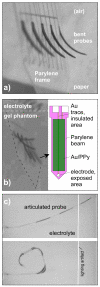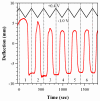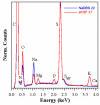Characterization of conjugated polymer actuation under cerebral physiological conditions
- PMID: 24574101
- PMCID: PMC4106983
- DOI: 10.1002/adhm.201300610
Characterization of conjugated polymer actuation under cerebral physiological conditions
Abstract
Conjugated polymer actuators have potential use in implantable neural interface devices for modulating the position of electrode sites within brain tissue or guiding insertion of neural probes along curved trajectories. The actuation of polypyrrole (PPy) doped with dodecylbenzenesulfonate (DBS) is characterized to ascertain whether it can be employed in the cerebral environment. Microfabricated bilayer beams are electrochemically cycled at either 22 or 37 °C in aqueous NaDBS or in artificial cerebrospinal fluid (aCSF). Nearly all the ions in aCSF are exchanged into the PPy-the cations Na(+) , K(+) , Mg(2+) , Ca(2+) , as well as the anion PO4 (3-) ; Cl(-) is not present. Nevertheless, deflections in aCSF are comparable to those in NaDBS and they are monotonic with oxidation level: strain increases upon reduction, with no reversal of motion despite the mixture of ionic charges and valences being exchanged. Actuation depends on temperature. Upon warming, the cyclic voltammograms show additional peaks and an increase of 70% in the consumed charge. Bending is, however, much less affected: strain increases somewhat (6%-13%) but remains monotonic, and deflections shift (up to 20%). These results show how the actuation environment must be taken into account, and demonstrate proof of concept for actuated implantable neural interfaces.
Keywords: bilayers; brain-machine interface; conducting polymers; movable electrodes.
© 2014 WILEY-VCH Verlag GmbH & Co. KGaA, Weinheim.
Figures






Similar articles
-
Exchanged cations and water during reactions in polypyrrole macroions from artificial muscles.Chemphyschem. 2014 Feb 3;15(2):293-301. doi: 10.1002/cphc.201300878. Epub 2014 Jan 20. Chemphyschem. 2014. PMID: 24446168
-
Effect of the electrolyte concentration and substrate on conducting polymer actuators.Langmuir. 2014 Apr 8;30(13):3894-904. doi: 10.1021/la404353z. Epub 2014 Mar 24. Langmuir. 2014. PMID: 24605916
-
Concept of an artificial muscle design on polypyrrole nanofiber scaffolds.PLoS One. 2020 May 11;15(5):e0232851. doi: 10.1371/journal.pone.0232851. eCollection 2020. PLoS One. 2020. PMID: 32392238 Free PMC article.
-
Polypyrrole-based conducting polymers and interactions with biological tissues.J R Soc Interface. 2006 Dec 22;3(11):741-52. doi: 10.1098/rsif.2006.0141. J R Soc Interface. 2006. PMID: 17015302 Free PMC article. Review.
-
Conducting polymers for neural interfaces: challenges in developing an effective long-term implant.Biomaterials. 2008 Aug-Sep;29(24-25):3393-9. doi: 10.1016/j.biomaterials.2008.04.047. Epub 2008 May 23. Biomaterials. 2008. PMID: 18501423 Review.
Cited by
-
Update in facial nerve paralysis: tissue engineering and new technologies.Curr Opin Otolaryngol Head Neck Surg. 2014 Aug;22(4):291-9. doi: 10.1097/MOO.0000000000000062. Curr Opin Otolaryngol Head Neck Surg. 2014. PMID: 24979369 Free PMC article. Review.
-
Electrochemically actuated microelectrodes for minimally invasive peripheral nerve interfaces.Nat Mater. 2024 Jul;23(7):969-976. doi: 10.1038/s41563-024-01886-0. Epub 2024 Apr 26. Nat Mater. 2024. PMID: 38671159 Free PMC article.
-
Soft-robotic ciliated epidermis for reconfigurable coordinated fluid manipulation.Sci Adv. 2022 Aug 26;8(34):eabq2345. doi: 10.1126/sciadv.abq2345. Epub 2022 Aug 26. Sci Adv. 2022. PMID: 36026449 Free PMC article.
-
Development of a smart guide wire using an electrostrictive polymer: option for steerable orientation and force feedback.Sci Rep. 2015 Dec 17;5:18593. doi: 10.1038/srep18593. Sci Rep. 2015. PMID: 26673883 Free PMC article.
References
-
- Smela E. Conjugated polymer actuators for biomedical applications. Adv. Mater. 2003;15:481–494.
-
- Immerstrand C, Holmgren-Peterson K, Magnusson KE, Jager E, Krogh M, Skoglund M, Selbing A, Inganäs O. Conjugated-polymer micro- and milliactuators for biological applications. MRS Bull. 2002;27:461–464.
-
- George PM, Lyckman AW, LaVan DA, Hegde A, Leung Y, Avasare R, Testa C, Alexander PM, Langer R, Sur M. Fabrication and biocompatibility of polypyrrole implants suitable for neural prosthetics. Biomaterials. 2005;26:3511–3519. - PubMed
-
- Green RA, Lovell NH, Wallace GG, Poole-Warren LA. Conducting polymers for neural interfaces: Challenges in developing an effective long-term implant. Biomaterials. 2008;29:3393–3399. - PubMed
-
- Lee KKC, Munce NR, Shoa T, Charron LG, Wright GA, Madden JD, Yang VXD. Fabrication and characterization of laser-micromachined polypyrrole-based artificial muscle actuated catheters. Sens. Act. A. 2009;153:230–236.
Publication types
MeSH terms
Substances
Grants and funding
LinkOut - more resources
Full Text Sources
Other Literature Sources
Miscellaneous

